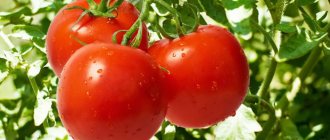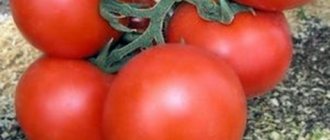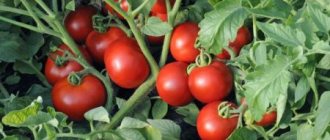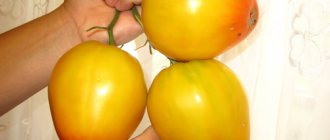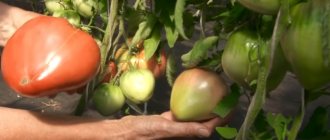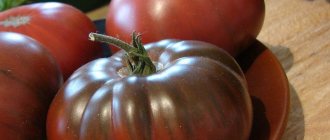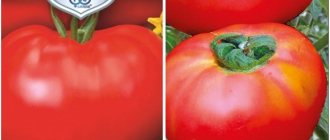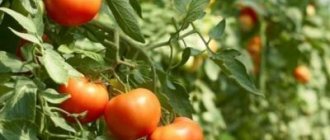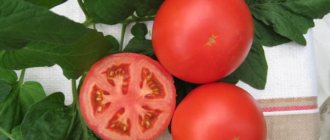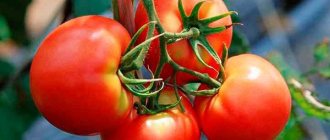Description of the tomato variety “Boogie Woogie F1”
The variety belongs to early ripening tomatoes. Tomatoes fully ripen 103 days after germination. The indeterminate type bush does not grow higher than 1.30 m, but has significant foliage and spreading. The leaves are dark green, simple.
Fruit
The tomatoes are large, regular flat-round in shape. They grow in clusters of 3-5 pieces. The ribbing is weakly expressed. The average weight of one tomato is 250-300 grams.
Other fruit features:
- Pink-red skin color;
- Absence of a green spot on the stalk;
- Juicy and sweet pulp.
81 varieties of tomatoes:
How to grow Boogie Woogie tomatoes
Among the hybrids and varieties of tomatoes, pink-fruited ones are considered the most delicious. Judging by the reviews of gardeners, the Boogie Woogie tomato fully confirms this opinion. In addition to beautiful fruits (see photo) and excellent taste, the hybrid is famous for its unpretentiousness and high yield rates. Recommended for regions with temperate climates, for cultivation in shelters (film and polycarbonate greenhouses, greenhouses).
Description of the variety
Boogie Woogie is a hybrid tomato characterized by fast ripening and resistance to adverse factors. Since 2007, the variety has been included in the State Register catalog and is grown in different areas.
The fruits ripen early, reaching technical ripeness after 100-103 days. On heavily leafy bushes, several clusters of 3-5 tomatoes each are formed. The plants are powerful, strong, although not particularly tall (up to 1.3 meters). The root system is well developed, the leaf blades are medium sized and bright green in color.
Ask and receive useful advice from professional gardeners and experienced summer residents.>>
It is recommended to grow plants in 1-2 trunks, cutting off excess leaves and removing stepsons in a timely manner.
Belongs to the indeterminate group, requires increased nutrition and timely watering. The fruits are smooth, beautiful, rich pink in color. There are no stripes or spots. By weight - 250-290 grams.
The pulp is very juicy, fleshy and dense. Inside there are 3-4 chambers, few seeds. Therefore, the fruits are used to prepare salads, pasta, ketchup, sauces, and soups. It must be taken into account that during processing the tomato mass is not bright red, but pinkish in color.
The fruits taste sweet, with a pleasant aroma. Sugar content is about 3%. The taste depends on the correct agricultural technology, regularity of fertilizing and watering.
Suitable for short-term storage and transportation. In boxes and boxes they keep their shape and retain their presentation.
Advantages and disadvantages
The hybrid has no obvious disadvantages. It is hardly worth considering the need to form a bush and install trellises as a “minus”.
good tomato taste; high product characteristics; early ripening (important for regions with difficult climatic conditions); the ability to grow in shelters, on ridges; good yield (up to 5-6 kg per plant); friendly return of fruits; resistance to diseases (fusarium wilt, tobacco mosaic virus).
Gardeners note that the fruits can be canned and used for pickling (in slices). Hybrid Boogie Woogie F1 is planted in different areas, there are no particular complaints or negative reviews.
Features of agricultural technology
In most regions of the country, the hybrid is grown through seedlings. The timing of sowing seeds is calculated based on the climate and growing conditions (on ridges, in shelters).
The seedlings should be 58-65 days old at the time of planting, strong and healthy.
Before planting, tomatoes must be accustomed to new conditions. Hardening promotes rapid adaptation and increases plant immunity to diseases.
When the soil warms up to +14ºC...+16ºC, plants can be planted, following the distance recommendations. The hybrid has powerful growth, so leave at least 50-60 cm between the bushes.
Small tomato seedlings in beds are initially covered with non-woven material or film and watered after planting no earlier than 5-6 days later.
Further standard care:
- rare but abundant watering;
- adding nutrient mixtures (3-4 times during the summer);
- loosening;
- mulching;
- formation of bushes;
- regular removal of stepchildren.
Preventative spraying of the variety against diseases and pests is carried out. The tomato is little susceptible to infections; it “escapes” late blight due to the early ripening of the fruit.
In the first period of the growing season, nitrogen makes up a significant proportion of the fertilizing, and in the second half - potassium and phosphorus. Watering a hybrid tomato with an infusion of herbs and yeast gives a good effect.
Harvest tomatoes as they ripen. It is allowed to harvest tomatoes at the stage of technical ripeness in order to allow the next batches of fruit to form
The Boogie Woogie tomato is one of the promising hybrids recommended for cultivation on farms and on the plots of amateur gardeners.
Tomatoes: advantages and disadvantages
Advantages of this variety:
- Fast ripening;
- Excellent product and taste qualities;
- High yield;
- Keeping quality for a long period;
- Immunity to specialized diseases of nightshade crops.
Being a first generation hybrid, Boogie Woogie has virtually no disadvantages. The negative features of the variety include :
- Demanding on shaping and gartering;
- The need for annual renewal of seed material.
Boogie Woogie F1 tomato seeds indet. early 105-115 days. env. 180-250 gr. roses (Elite series)
Order by phone
- +38 ( 050 ) 699-12-64
- +38 ( 066 ) 827-50-68
- +38 ( 066 ) 827-50-68
- +38 ( 067 ) 771-68-61
- +38 ( 068 ) 347-43-44
- +38 ( 097 ) 058-95-54
- +38 ( 093 ) 348-47-82
- +38 ( 063 ) 238-93-97
Important
No minimum order amount! But prepayments are required:
- for orders up to 200 UAH;
- for goods to order - 100% prepayment;
- Each order contains a gift.
Delivery methods
Every day:
For order values over 2,500 UAH and weight up to 500 grams, delivery is free (from 12/15/2018)
Discounts
When ordering for 3,000 UAH - 3% discount, 5,000 UAH - 5% discount, 10,000 - 10% discount
Discounts cannot be combined!
Delivery
Ukrposhta:
- cash on delivery – from 35 UAH (per parcel) + 8 UAH and 1% of the amount for cash on delivery
- prepayment – 35 UAH
New mail:
- cash on delivery – from 40 UAH + money transfer 20 UAH + 2%
- prepayment – from 40 UAH
Autolux:
- cash on delivery – from 25 UAH + for cash on delivery 15 UAH + 2% of the cost of the parcel
- prepayment – from 25 UAH
Receive gifts by ordering online
Each customer who places an order online (by registering in the store and making purchases through the basket) receives a magazine, a package of seeds and a calendar as a gift (included in the order from September to January).
Contacts for placing an order in the ATO zone
We accept orders for vegetable seeds from the ATO zone
Telephone: 066 061 04 03
Tomato Boogie Woogie F1 description:
The Boogie Woogie tomato is an indeterminate pink large-fruited tomato from the Elite Row company.
From germination to ripening 100 – 105 days.
Indeterminate early-ripening pink-fruited hybrid, without a green spot on the stalk.
The shape of the fruit is from flat-round to heart-shaped.
The fruits are dense and transportable. The raceme is complex, with from 6 to 12 fruits.
The first brush is placed above the 8th - 9th sheet.
Fruit weight is 150-300 grams. Productivity – 17 kg/sq.m.
Planting scheme: 3 plants per 1 sq.m.
The taste is very high.
Resistant to TMV, septoria, macrosporiosis.
Features of hybrid growth:
- it is necessary to regulate the load of the crop on the hands.
- To obtain large, even tomatoes, leave no more than 5–6 fruits on the bunch.
Tomato seeds Boogie Woogie F1 (Elite range) can be in two types of packaging:
- original packaging (from the manufacturer)
- Seed Supermarket packaging.
If you only need seeds in original packaging, please indicate this in the comments to your order or tell the sales consultant this when placing your order by phone.
The manufacturer reserves the right to change the packaging design, color and availability of seed treatment.
If this item does not have a package with a suitable number of seeds, please inform our sales manager - he will try to help you open the package or offer a suitable analogue.
Characteristics
| Fetal weight | 180-250 gr. |
| Variety or hybrid | Hybrid |
| Ripening period | Early |
| Fruit type | large-fruited tomatoes (180-250 g) |
| Plant type | Indeterminate |
| Form | Rounded-flattened |
| Color | Pink |
| Plant height | Tall (from 1.8 to 3 m) |
| Ripening time, days | 105-115 days |
| GROWING: ZG | Yes |
| GROWING: turnover | 1st revolution |
| GROWING: OG | Yes |
| GROWING: Film greenhouses | Maybe |
| GROWING: Glass greenhouses | Ineffective |
| USAGE: For fresh market | Yes |
| Fruits on the plant | 5-6 pcs. on the hand |
| Recommended density thousand plants/ha | 180-250 seeds/area |
| GROWING METHOD: seedling method | Yes |
| Harvesting method | Manual cleaning |
| Transportability | Yes |
| Disease resistance: HR | to a number of diseases |
| Growing season, days (p.v.r.) | 60-70 days |
| GROWING: on heavy soils | Allowed |
| GROWING: planting scheme | 1.8-2.5 plants/m2 |
| GROWING: plastic greenhouses | Maybe |
| USAGE: For juices | Maybe |
| CULTURE: Daylight | photophilous culture |
| CULTURE: Shade tolerant | Relatively stable |
Growing tomatoes
Like other varietal tomatoes, “Boogie Woogie” is grown in seedlings and then planted in a stationary greenhouse, hotbed or open ground. The variety has a tendency to quickly degenerate, so self-collected seeds do not germinate. For each sowing you need to buy new material.
How to prepare seeds?
Seeds of F1 hybrids are sold completely ready for planting. To improve germination and shorten the growing season, you can treat them with growth stimulants: “Sodium Humate”, “Epin Extra”. A solution of wood ash is used as a cheap alternative.
Sowing seed material
Sowing is carried out in March - approximately 2 months before the expected date of the last frost. As soil for seedlings, mix turf and humus in a 1:1 ratio. If necessary, dilute with sand. The seeds are laid out on the surface at intervals of 3 cm from each other, then sprinkled with peat and watered abundantly.
Optimal temperature for keeping seedlings:
- Before emergence – 25*C;
- During the hardening period (within a week after the sprouts “peck”) – 16-18*C;
- Before planting in the garden – 20-22*C.
IMPORTANT : For sowing, you can use any container with a depth of 5 cm or more that has a sufficient number of drainage holes, including containers for cookies and sweets, “chests” made of tetrapacks, and wooden boxes. Picking is usually carried out in cut plastic bottles or peat pots.
Picking is carried out after the formation of the second true leaf. Seedlings need to be constantly watered, keeping the soil moist, and periodically fed with complex fertilizers.
Rules for planting seedlings
At two months of age, the seedlings are transplanted to a permanent location. In open ground - in the 2-3rd decade of May, in a greenhouse - in late April - early May. The earth at this time should be warmed up to 10*C, and the average daily air temperature should be about 15*C. The plants are transplanted into pre-prepared planting holes 12-15 cm deep. Superphosphate and a small amount of wood ash are placed under each bush.
IMPORTANT : When replanting, it is extremely important not to damage the roots of the plant. The most convenient option is replanting in a peat pot.
Recommended planting pattern:
- The distance between plants is 50 cm;
- Row spacing – 60 cm;
- The maximum planting density is 6 plants per 1 sq.m.
When planting “Boogie Woogie” in open ground, you should cover the plants with film at night during the first week.
Fruit characteristics and cultivation
Next, the characteristics of the Boogie-Woogie variety and the features of its cultivation will be presented. Tomato Boogie Woogie F1 loves a lot of light. Grown in open ground under the warm rays of the sun, they acquire a sweet taste. To prevent the plant from getting a fungal disease and starting to rot, you should follow the watering schedule and maintain low humidity in the room.
To do this, you need to ventilate the room often and do not overwater the soil. When watering, you should try not to touch the leaves and stems; it is better to keep them dry. The optimal air temperature is +23…+25 ºС.
Like most hybrid varieties, typical tomato diseases are:
- fusarium;
- verticillium;
- nematodes;
- tobacco mosaic.
See also
Description of Vasilina tomato fruits and general characteristics of the variety
Read
Tomatoes almost never get affected by late blight because they ripen early.
Many agronomists advise mulching the soil, which protects the soil surface from drying out. You need to take: straw, mowed grass, sawdust leaves, compost, film, as well as newspapers or cardboard. The bottom line is that any of these coatings acts as a barrier from the sun's rays, which means the soil will not dry out quickly and need frequent watering. But in a confined space, you need to ensure that the air humidity level does not increase due to water evaporation.
The best time to plant seeds is the end of March - beginning of April. For the purpose of disinfection and disinfection, seeds are dipped into a light solution of potassium permanganate before planting. Planting is done in a small container and covered with a thin film. There is no need to water the planted seeds. As the soil dries, it is better to spray them with water. Until the first sprout appears, the container is kept warm, but then it is transferred to a bright place so that the plant begins to grow quickly.
When the leaves on the seedlings get stronger, you can proceed to planting in the ground. When planting, there should be a distance of at least 50 cm between plants. Every 2 weeks you need to fertilize with complex fertilizer or organic matter. Tall bushes should be tied to a support. This way the plant will receive more light and will be easier to care for. To ensure that tomatoes receive enough nutrients, you need to remove the lateral shoots that appear between the stem and leaf.
Bush care
The most difficult part of Boogie Woogie cultivation is proper pruning. Bushes are formed into 1-2 stems, depending on planting density. Lateral stepsons above the 3rd hand must be removed regularly. It is best to do this when the length of the shoot is 4-5 cm. This reduces the risk of confusing the stepson with a growth shoot and creates the opportunity to leave a “stump” to prevent the appearance of a stepson in the same place in the future.
Other rules of care:
- Tall bushes may fall to the ground during the fruiting period, so they need to be promptly tied to supports, trellises or the greenhouse frame. Contact of tomatoes with the soil surface provokes the development of fungal diseases and impairs the quality of tomato ripening;
- Plants need shallow (up to 25 cm into the soil) watering every 3-5 days. The need for watering is determined when the top layer of soil dries. The following recommendations should be followed : Use only settled warm water;
- Water early in the morning or late in the evening;
- Avoid contact of liquid with green parts of plants;
- In the intervals between waterings, the soil must be loosened, preventing the earth crust from hardening;
Description of the Kokhava tomato and characteristics of the variety
Tomato Kokhava f1 is an indeterminate hybrid, which was bred by Russian breeders. A positive characteristic of the variety is its high yield and early ripening. The plant is characterized by good immunity and is resistant to many diseases.
Plant characteristics
Kohava is a hybrid that is also indeterminate and quite tall. The plant has medium leaves that are dark green in color and forms a strong root system. The tomato has simple inflorescences; on average, 5-6 tomatoes are formed on one ovary.
Due to its parameters and characteristics, the plant is characterized by a good immune system and is not afraid of diseases such as late blight. But at the same time, damage from external pests cannot be ruled out. Therefore, if damage to the trunk and leaves from pests is noticeable, it is better to treat the plant with a weak solution of manganese.
The downside of the plant is that it is a hybrid, so getting seeds for next year to grow seedlings will be quite a painstaking task.
Description of the fruit
The fruits have a flat-round shape and a pale pink color. The average weight of a ripe fruit is 150 grams. On average, 5-6 fruits ripen on one cluster. The weight and size of a tomato depends on the number of tomatoes ripening on the bush. The fruit has a bright red color and an interesting shape.
Vegetables of this variety are characterized by good keeping quality and are convenient to transport over long distances. This variety is not characterized by cracking. In this case, the tomato will not lose its presentation.
If you store vegetables in a cool place, they can last for a long time. Tomatoes can be used both for fresh consumption and for preservation. The rather large fruit makes it possible to effectively use tomatoes for tomato juice.
How is sowing done?
The tomato is a hybrid, so the seeds must be purchased at a specialty store. Before planting seeds, it is necessary to prepare the soil and treat the seeds with manganese. This must be done to prevent future tomatoes from contracting the disease. The seeds are sown to a depth of 2 cm and the box must be placed in a warm and sunny place.
After the seeds have hatched, after the first leaf it is necessary to prick the seedling in order for it to strengthen. Plants must be planted when they are 55 days old. To obtain earlier fruits, you can plant seedlings in a greenhouse. Care consists of regular watering, loosening the soil and fertilizing the plant. On average, there are 3 adult plants per 1 square meter. In these growing conditions they will feel comfortable and bear fruit.
Diseases and pests
"Boogie Woogie" is highly resistant to disease:
- Tobacco mosaic;
- Fusarium;
- Golden nematode;
- Verticillium.
Due to early ripening, the variety does not suffer from late blight. To prevent fungal diseases, preventive measures should be taken :
- Maintain air exchange in the garden bed and in the soil;
- Find the optimal watering rate at which the soil would be sufficiently moist, but the liquid would not stagnate in the garden bed;
- Mulch the rows with chopped straw or peat. This saves the soil from overheating and inhibits the growth of weeds.
Of the pests, the greatest damage to plants is caused by the Colorado potato beetle, spider mite and cutworm. To combat insects, tomatoes are sprayed with the insecticides Fitoverm and Karbifos.
a brief description of
- Where to grow: in greenhouses and open ground
- Bush height, cm: 120–130
- Ripening time, days: 103
- Productivity, kg: 4–5 per bush
- Fruit weight, g: up to 300
- Application: salads and vegetable dishes, preparations
- Advantages : large fruit;
- transportability;
- ripening;
- resistance to diseases and pests;
- productivity.
- trunk formation;
Growing
The optimal growing method is seedlings. To do this, in mid-March, the seeds are disinfected with a solution of potassium permanganate or hydrogen peroxide. Soak overnight in a growth stimulator.
The soil mixture can be purchased at the store or prepared independently from turf soil, humus, and ash. The seeds are placed in a container on compacted soil. Sprinkle with a 1-1.5 cm layer of peat. Provide a temperature of 23-25˚C. Cover with film and keep warm until germination.
The seedlings are freed from shelter and moved to a sunny place. Water with a spray bottle or through a strainer and loosen. After several full-fledged leaves appear, they are picked and fertilized. A week before transplanting to the dacha, the seedlings are hardened off - taken out into the fresh air or onto the balcony. At first, such “walks” last 2–3 hours. Gradually their duration increases.
In the garden plot, the beds are first dug up with humus and ash. A tablespoon of fertilizer - superphosphate and potassium sulfate - is added to the wells. Planting pattern – 40 x 60 cm. Plants from open ground are covered with film for the first few days.
Conventional agricultural technology for tomatoes:
- watering after sunset;
- mulching;
- ventilation of the greenhouse;
- loosening;
- weeding.
"Boogie Woogie" needs to form a stem (removing side shoots above the 3rd brush and above), tying it to a vertical support. You can place supports under the lower branches with fruits. The variety is rarely attacked by insects and diseases. Proper care will help you avoid problems.
The best and worst varieties of tomatoes: which ones to plant and which ones to avoid?
We recently celebrated the New Year and it would seem that spring is still far away, but the gardener’s heart is already beating faster in anticipation of the planting campaign. But what varieties of tomatoes should you choose so that the coming year’s harvest does not disappoint?
Last year, the clear favorites when choosing seeds were tomatoes: Honey Drop, Black Moor, Mazarin, King of the Market2, Sanka, which justified themselves with a bountiful harvest. Perhaps only Mazarin disappointed many by not showing the declared qualities.
Feedback from gardeners on tomato yield results will give you an idea of many varieties of tomatoes. As a result of the analysis, you yourself will be able to compile for yourself a list of seeds that you will purchase for planting.
Positive reviews about tomato varieties
- Appetizing
from Sib.garden - the most delicious and productive. - Ox heart
- tasty large fruits, but very late. - Bonsai
from Gavrish (I bought 2 packs, but I couldn’t find them this season and my husband was whining all summer), - Bourgeois
- medium-sized tomatoes, 100-120g, but the bushes are productive, bear fruit from early July to mid-October, the taste is acceptable; - Ox heart
- tasty large fruits, but very late. I manage to shoot a couple of brushes in red - Budenovka
- liked it. Large, pink, fleshy, sugary. One of the first to ripen. The shape of the fruit corresponds to the name. The taste, I would say, is delicate, but not sweet. - Red giant
- large fruits (up to 800g first, but then not small), tasty; - Black pear
. It was the most abundant. Tomatoes (to our taste) turned out to be tastier than Gypsy/Chernomor, - De barao black
. I was very pleased. - De Barao
. Pink is tastier than red, beautiful when pickled (but not tastier than some other tomatoes), lies well, the skin, like all de Barao’s, is not thick, diseases do not stick. - Wild rose
- not a lot of fruit, but the taste is good, I didn’t get sick with anything; - Golden canary
- tasty, productive - Golden domes
are good in taste, but my yield was low. - Golden shower
is the shape of a small pear. They were noticeably larger in the greenhouse than in the greenhouse - Cossack
- light brown-pink, productive. - The King of Giants
and
Cosmonaut Wolves
impressed with their size and taste. Very dense, large tomatoes (even the last ones were at least 150 grams), sugary in structure, and can be stored for quite a long time.
I really liked the caramel The cluster is long, very decorative, the fruits are round, even, do not crack, the taste is excellent, pronounced tomato, sweet.- The malachite box
is sweet, fruitful, and extremely tasty. - Honey saved
is delicious, I’ll keep it, of course, but I wasn’t impressed with the quantity and suffered from crown rot. - Honey drop
- super! The fruits are yellow, resembling a drop of honey. Rich brushes. - Eagle's beak
is an excellent, delicious tomato, a very productive variety. I will definitely leave it. - Pepper-shaped
; Weighty, tasty, meaty and sweet tomatoes were simply sold out with a bang. I’ll definitely plant it in the new season! - Parsley gardener
is short-growing, the tomatoes are not large, the taste is similar to my favorite pink honey, quite productive (but not super-super), most of all suffered from blossom end rot. - Pink honey, Sevruga, Mazarin
- identical heart-shaped ones, but Sevruga is still among the favorites. - Pink Andromeda
- as an early variety it was an excellent variety, it bore fruit for a long time, but the quality of the first harvests was better; - Pink honey
is unproductive, but the most delicious, beloved. - Pink helmet
- tastes similar to pink honey, but smaller and just as barren. - Sonata
- productive, tasty - Semko-Sinbad
- the pickled ones turn out really good! - Supersteak
- the fruits have not grown to the stated size, but the clusters are 6-8 pcs and all the tomatoes are the same, the bushes are strong, the garter is minimal (the taste, however, can be better); - Sanka
is a very abundant variety, the taste is good. Good in bed. I'm leaving it! - Santa Claus
- pleases every year, but the fruits become smaller (a feature of the variety), tasty, very sweet; - Sweet Cherry
- very sweet, cheerful berries! Red ones are larger than yellow ones, but yellow ones are sweeter. - Persimmon
- beautiful, fleshy, productive, did not hurt. The variety is very good, I have had it for 8 years, year after year it gets better, no green spot, moreover, the place where the stalk is attached is tiny. - Nocturne and Intuition
(hybrids) are abundant and last a long time. - dates
are very productive, you’ll be tortured to harvest them. They were the first to ripen. The taste is sweet and sour. I didn’t like the fact that when overripe, the peel wrinkles and becomes very tough. - Black Moor
is tasty, productive, unpretentious, ideal for pickling and is a delight to eat fresh! - the Gypsy
- I planted it for 3 years, it’s a tasty harvest, it sets fruit both in the heat and in the fall. Quite resistant to late blight, mildly affected in late autumn. - Um the champion
is great. tasty, productive, early (on par with Sanka), completed at the end of August, stepson up to the first brush. The only drawback is that ripe fruits are not stored at all. But for juice or ketchup, in salads - just right!
Didn't like these tomato varieties
- Atlantis
(SibSad) - terrible small (50-60 gr.) sour, on a powerful and strong trunk, although it didn’t hurt. - Boni MM
- I didn’t like it at all, neither in taste nor in quantity, and I didn’t have it at all early. - Bobcat and Slot
are productive, but the taste is the most common, market one. - Boogie - woogie
- not early and tasteless. - Yellow cherries
- tasty, sweet, lots of them, but very small and almost all of them were cracked - Irishka F1
(Russian vegetable garden) - cold-resistant, unpretentious, so-so, nothing special. - Koenigsberg red
- suffered from blossom end rot, low yield. - A Moscow delicacy
- very tasty, meaty icicles. Not very productive. Sick with Koenigsberg from apical rot - Honey-sugar
(SibSad) - “oak” store-bought tomatoes, although yellow in color, lasted the longest on the windowsill, but the taste changed for the worse. - The mandarin duck
was not impressed, in my opinion the honey drop is better, although the tomato is half the size. - Mazarin
was not impressed. - Eagle Heart
- I got sick first, I didn’t get any tomatoes. - Pink Leader
is the worst variety of this year in terms of fruit taste and yield. - Siberian Lights
- large cream, but empty inside - Timofeich
- fruitful, sweet and sour taste - Wonder of the world
- a lot of tomatoes, bears fruit for a long time, is unpretentious. Beautiful fruits with a spout. The taste is sour both in salads and in preparations. In salads, the juice is white-yellow-watery. LET'S CLEAN UP! - Jason
(Zedek) - tasteless
Source: Wow! Dacha
Read more about tomato varieties here! Share with your friends!
Read on topic:
Propagation of cucumbers by cuttings
Tomato variety Pink honey
You can grow cherry tomatoes in hanging baskets
Which is correct: no tomatoes or no tomatoes?
